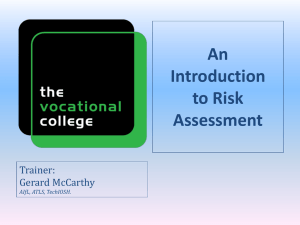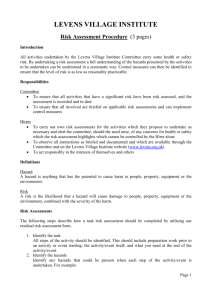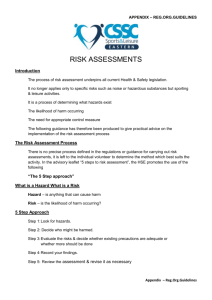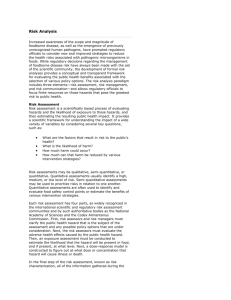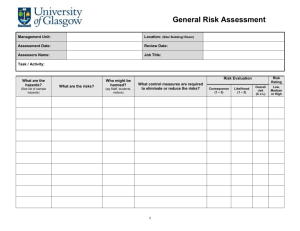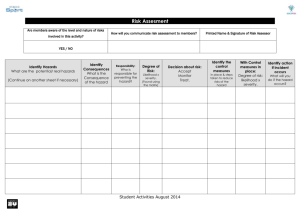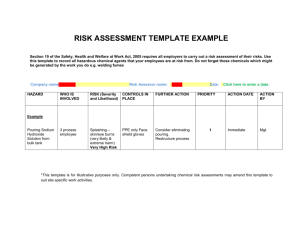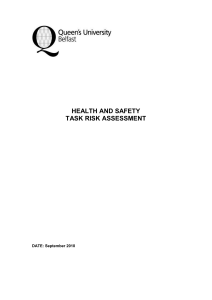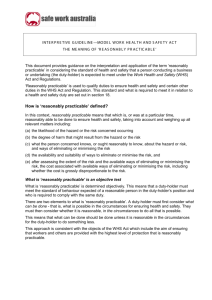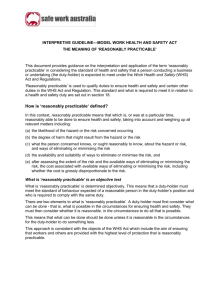Significant Findings of Risk Assessments
advertisement
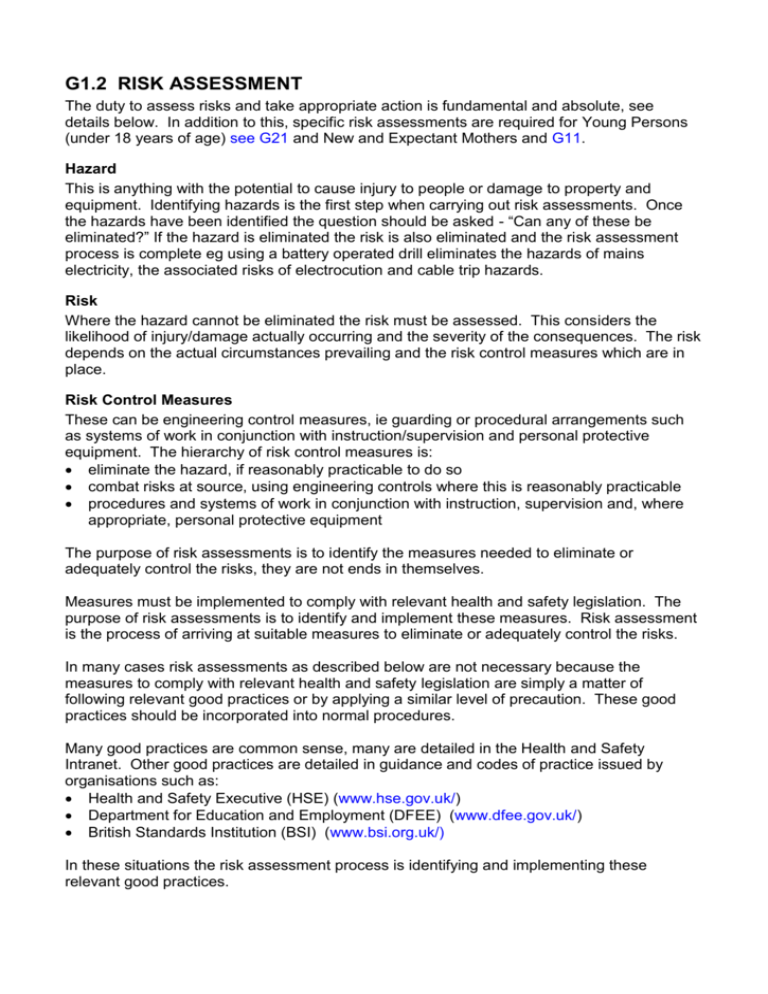
G1.2 RISK ASSESSMENT The duty to assess risks and take appropriate action is fundamental and absolute, see details below. In addition to this, specific risk assessments are required for Young Persons (under 18 years of age) see G21 and New and Expectant Mothers and G11. Hazard This is anything with the potential to cause injury to people or damage to property and equipment. Identifying hazards is the first step when carrying out risk assessments. Once the hazards have been identified the question should be asked - “Can any of these be eliminated?” If the hazard is eliminated the risk is also eliminated and the risk assessment process is complete eg using a battery operated drill eliminates the hazards of mains electricity, the associated risks of electrocution and cable trip hazards. Risk Where the hazard cannot be eliminated the risk must be assessed. This considers the likelihood of injury/damage actually occurring and the severity of the consequences. The risk depends on the actual circumstances prevailing and the risk control measures which are in place. Risk Control Measures These can be engineering control measures, ie guarding or procedural arrangements such as systems of work in conjunction with instruction/supervision and personal protective equipment. The hierarchy of risk control measures is: eliminate the hazard, if reasonably practicable to do so combat risks at source, using engineering controls where this is reasonably practicable procedures and systems of work in conjunction with instruction, supervision and, where appropriate, personal protective equipment The purpose of risk assessments is to identify the measures needed to eliminate or adequately control the risks, they are not ends in themselves. Measures must be implemented to comply with relevant health and safety legislation. The purpose of risk assessments is to identify and implement these measures. Risk assessment is the process of arriving at suitable measures to eliminate or adequately control the risks. In many cases risk assessments as described below are not necessary because the measures to comply with relevant health and safety legislation are simply a matter of following relevant good practices or by applying a similar level of precaution. These good practices should be incorporated into normal procedures. Many good practices are common sense, many are detailed in the Health and Safety Intranet. Other good practices are detailed in guidance and codes of practice issued by organisations such as: Health and Safety Executive (HSE) (www.hse.gov.uk/) Department for Education and Employment (DFEE) (www.dfee.gov.uk/) British Standards Institution (BSI) (www.bsi.org.uk/) In these situations the risk assessment process is identifying and implementing these relevant good practices. When considering what health and safety measures are appropriate it is legitimate to take costs into account. Where relevant good practice is not defined, or where there is doubt: the magnitude of the risks, both in terms of the severity of foreseeable injury and the likelihood of occurrence, must be assessed (trivial risks can be ignored altogether); the risks should then be roughly balanced against the cost of reducing them; arrangements must be made to reduce or eliminate the risks unless the cost of doing so is obviously unreasonable compared with the risk. Common sense is often all that is necessary. But remember the human consequences: the balance must be firmly on the side of health and safety. CARRYING OUT RISK ASSESSMENTS Look for the hazards Hazard identification is the first step. Look for anything, work practices, substances and equipment with the potential to cause harm. Inspecting the workplace helps, as does assessing information in the hazard data sheets from product suppliers. Guidance from Health and Safety Advisers, the Health and Safety Executive and other organisations may help. In many cases, identifying hazards is simply common sense. A torn carpet or broken electrical socket are easily spotted by people with no specialist knowledge. In practice, most people probably check their department or workplace every day. Their knowledge, experience and common sense are invaluable. But be sure that their 'common sense' is not based on incorrect perceptions. For example, most people are well aware of technical and chemical hazards (because they may cause serious but usually infrequent incidents) but can be heedless of 'routine' hazards (like poorly maintained floors or congested work areas) that cause less serious accidents more often. Decide who might be harmed, and how Hazards will not all result in harm. The degree of damage or harm caused by the same type of hazard will depend on the circumstances. For example, a broken floor tile in a walk-in stationery store might cause someone to trip, but this would be unlikely. The same broken tile in the main corridor would be much more likely to cause an accident. If the broken tile was on a staircase, not only would the likelihood of someone tripping be very high but the consequences of the fall could be serious, e.g. a broken hip. Deciding how much harm a hazard might cause and how often harm might arise is called 'risk assessment'. Evaluate the risks and implement appropriate risk control measures The risk will depend on the control measures in place or proposed and will be a combination of the likelihood of occurrence and the severity of harm. The risk must be reduced “so far as is reasonably practicable”. To address a problem to the extent of “so far as is reasonably practicable”, usually means to ascertain and apply up-to-date good practice, where good practice is not specified or obvious it is reasonable to weigh the seriousness of the risk against the difficulty and cost of reducing it. In such cases, risk-reducing measures must legally be pursued up to the point where any further steps would be wholly disproportionate to the benefits those steps may be expected to secure. To help prioritise actions numerical values can be attributed to the likelihood of occurrence and the severity of harm. A 1-5 scale is adopted for this purpose as shown below. The risk rating is calculated with the existing or proposed controls in place. Numerical values can help but are not an essential part of risk assessment and need not be used. Value 1 2 3 4 5 Likelihood of Occurrence Rare Unlikely Moderate Likely Almost certain Value 1 2 3 4 5 Severity of Harm Minor Moderate Significant Major Catastrophic Risk Rating = Likelihood of Occurrence x Severity of harm Date last updated 14.6.07 SIGNIFICANT FINDINGS OF RISK ASSESSMENTS Directorate Hazard Area/Activities Who might be harmed Carried out by Existing Controls (Or proposed controls in the case of a new activity) *Risk rating with existing or proposed controls Date Are risks adequately controlled Yes/No 1 Rare, 2 Unlikely, 3 Moderate, 4 Likely, 5 Almost Certain Severity of injury 1 Minor, 2 Moderate, 3 Significant, 4 Major, 5 Catastrophic Date last updated 14.06.07 of If No, what further actions are required to reduce the risks *Risk Rating = Likelihood of Occurrence x Severity of Harm (Not essential, can help in prioritising actions) Likelihood of Occurrence Sheet
